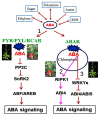The Physiological and Molecular Mechanism of Abscisic Acid in Regulation of Fleshy Fruit Ripening
- PMID: 33505417
- PMCID: PMC7829184
- DOI: 10.3389/fpls.2020.619953
The Physiological and Molecular Mechanism of Abscisic Acid in Regulation of Fleshy Fruit Ripening
Abstract
The ripening of fleshy fruits is coupled with the degradation of both chlorophyll and cell walls, as well as changes in the metabolism of phenylpropanoids, flavonoids, starch/sucrose, and carotenoids. These processes are controlled by phytohormones and other factors, including abscisic acid (ABA), ethylene, auxin, polyamines, sugar, and reactive oxygen species. The ripening of climacteric fruits is controlled by ethylene and non-climacteric fruit ripening is regulated mainly by ABA. Also, ABA and ethylene may interact in both types of fruit ripening. ABA concentrations in fleshy fruits are regulated in response to developmental and environmental cues and are controlled by the relative rates of ABA biosynthesis and catabolism, the former mainly via 9-cis-epoxycarotenoid dioxygenases (NCEDs) and β-glucosidases and the latter via ABA 8'-hydroxylases (CYP707As) and β-glycosyltransferases. In strawberry fruit ripening, ABA is perceived via at least two receptors, Pyrabactin resistance (PYR)/PYR-like (PYL) and putative abscisic acid receptor (ABAR), which are linked separately to the conserved signaling pathway ABA-FaPYR1-FaABIl-FaSnRK2 and the novel signaling pathway ABA-FaABAR-FaRIPK1-FaABI4. Downstream signaling components include important transcription factors, such as AREB (ABA responsive element binding protein)/ABF (ABRE binding factors ABA responsive factor), ethylene response factor (ERF), and V-myb Myeloblastosis viral oncogene homolog (MYB), as well as ripening-related genes. Finally, a comprehensive model of ABA linked to ethylene, sugar, polyamines, auxin and reactive oxygen species in the regulation of strawberry fruit ripening is proposed. Next, new integrated mechanisms, including two ABA signaling pathways, ABA and ethylene signaling pathways, and ABA/ethylene to other phytohormones are interesting and important research topics in ripening, especially in non-climacteric fruits.
Keywords: abscisic acid; ethylene; fruit ripening; non-climacteric fruit; review; signaling transduction.
Copyright © 2021 Bai, Huang and Shen.
Conflict of interest statement
The authors declare that the research was conducted in the absence of any commercial or financial relationships that could be construed as a potential conflict of interest.
Figures

Similar articles
-
Abscisic acid perception and signaling transduction in strawberry: a model for non-climacteric fruit ripening.Plant Signal Behav. 2011 Dec;6(12):1950-3. doi: 10.4161/psb.6.12.18024. Plant Signal Behav. 2011. PMID: 22095148 Free PMC article. Review.
-
Update on the Roles of Polyamines in Fleshy Fruit Ripening, Senescence, and Quality.Front Plant Sci. 2021 Feb 10;12:610313. doi: 10.3389/fpls.2021.610313. eCollection 2021. Front Plant Sci. 2021. PMID: 33664757 Free PMC article. Review.
-
Cloning and functional analysis of 9-cis-epoxycarotenoid dioxygenase (NCED) genes encoding a key enzyme during abscisic acid biosynthesis from peach and grape fruits.J Plant Physiol. 2009 Aug 15;166(12):1241-1252. doi: 10.1016/j.jplph.2009.01.013. Epub 2009 Mar 23. J Plant Physiol. 2009. PMID: 19307046
-
A leu-rich repeat receptor-like protein kinase, FaRIPK1, interacts with the ABA receptor, FaABAR, to regulate fruit ripening in strawberry.J Exp Bot. 2018 Mar 24;69(7):1569-1582. doi: 10.1093/jxb/erx488. J Exp Bot. 2018. PMID: 29281111 Free PMC article.
-
Fig fruit ripening is regulated by the interaction between ethylene and abscisic acid.J Integr Plant Biol. 2021 Mar;63(3):553-569. doi: 10.1111/jipb.13065. J Integr Plant Biol. 2021. PMID: 33421307
Cited by
-
Role of Basal ABA in Plant Growth and Development.Genes (Basel). 2021 Nov 30;12(12):1936. doi: 10.3390/genes12121936. Genes (Basel). 2021. PMID: 34946886 Free PMC article. Review.
-
Abscission zone metabolism impacts pre- and post-harvest fruit quality: a very attaching story.Front Plant Sci. 2025 Jan 27;15:1524893. doi: 10.3389/fpls.2024.1524893. eCollection 2024. Front Plant Sci. 2025. PMID: 39980759 Free PMC article. Review.
-
N6-methyladenosine RNA modification regulates strawberry fruit ripening in an ABA-dependent manner.Genome Biol. 2021 Jun 3;22(1):168. doi: 10.1186/s13059-021-02385-0. Genome Biol. 2021. PMID: 34078442 Free PMC article.
-
Editorial: Towards a better understanding of fruit ripening: Crosstalk of hormones in the regulation of fruit ripening.Front Plant Sci. 2023 Mar 9;14:1173877. doi: 10.3389/fpls.2023.1173877. eCollection 2023. Front Plant Sci. 2023. PMID: 36968374 Free PMC article. No abstract available.
-
The R2R3-MYB transcription factor FaMYB63 participates in regulation of eugenol production in strawberry.Plant Physiol. 2022 Mar 28;188(4):2146-2165. doi: 10.1093/plphys/kiac014. Plant Physiol. 2022. PMID: 35043961 Free PMC article.
References
-
- Araújo W. L., Tohge T., Osorio S., Lohse M., Balbo I., Krahnert I., et al. . (2012). Antisense inhibition of the 2-oxoglutarate dehydrogenase complex in tomato demonstrates its importance for plant respiration and during leaf senescence and fruit maturation. Plant Cell 24, 2328–2351. 10.1105/tpc.112.099002, PMID: - DOI - PMC - PubMed
-
- Azoulay S. T., Harpaz-Saad S., Belausov E., Lovat N., Krokhin O., Spicer V., et al. . (2008). Citrus chlorophyllase dynamics at ethylene-induced fruit color-break: a study of chlorophyllase expression, posttranslational processing kinetics, and in situ intracellular localization. Plant Physiol. 148, 108–118. 10.1104/pp.108.124933, PMID: - DOI - PMC - PubMed
Publication types
LinkOut - more resources
Full Text Sources
Other Literature Sources

